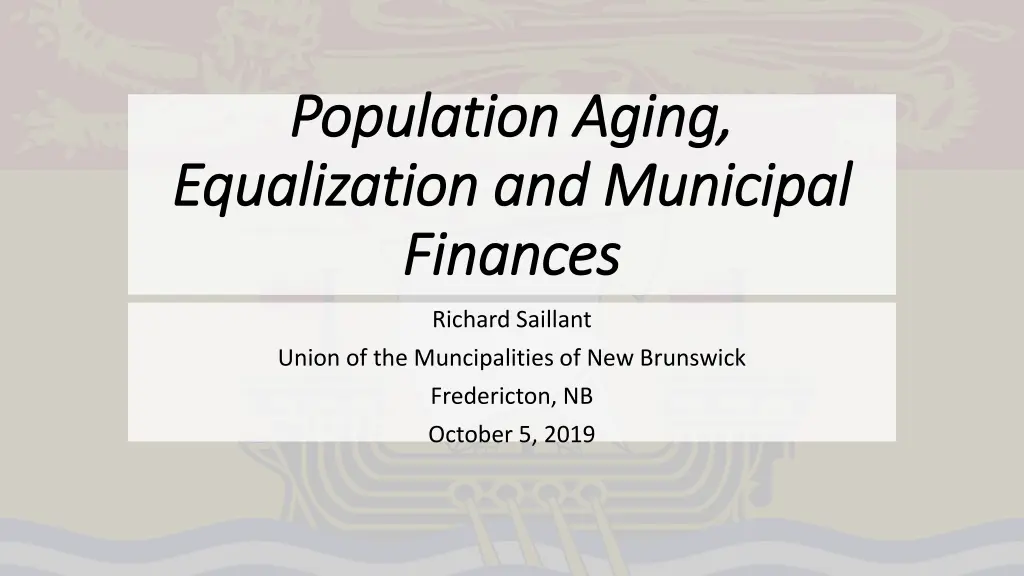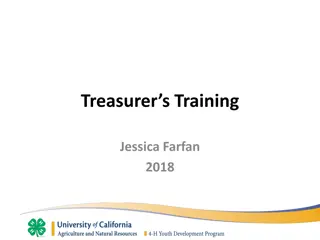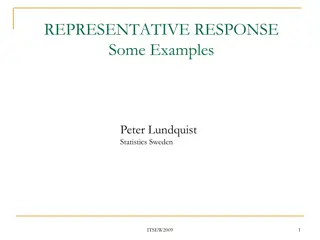
Understanding Population Aging, Equalization, and Municipal Finances in New Brunswick
Exploring the challenges and implications of population aging, equalization, and municipal finances in New Brunswick, with a focus on key concepts such as fiscal imbalance and the Byrne Report. The presentation discusses median age trends, population growth, and the unique characteristics of various regions within the province.
Download Presentation

Please find below an Image/Link to download the presentation.
The content on the website is provided AS IS for your information and personal use only. It may not be sold, licensed, or shared on other websites without obtaining consent from the author. If you encounter any issues during the download, it is possible that the publisher has removed the file from their server.
You are allowed to download the files provided on this website for personal or commercial use, subject to the condition that they are used lawfully. All files are the property of their respective owners.
The content on the website is provided AS IS for your information and personal use only. It may not be sold, licensed, or shared on other websites without obtaining consent from the author.
E N D
Presentation Transcript
Population Aging, Population Aging, Equalization and Municipal Equalization and Municipal Finances Finances Richard Saillant Union of the Muncipalities of New Brunswick Fredericton, NB October 5, 2019
2018 1971 100+ 100+ 95-99 95-99 90-94 90-94 85-89 85-89 80-84 80-84 75-79 75-79 70-74 70-74 65-69 65-69 60-64 60-64 55-59 55-59 50-54 50-54 45-49 45-49 40-44 40-44 35-39 35-39 Median age = 23.9 Median age = 23.9 Median age = 45.9 Median age = 45.9 30-34 30-34 25-29 25-29 20-24 20-24 15-19 15-19 10-14 10-14 5-9 5-9 0-4 0-4 40000 30000 20000 10000 0 10000 F 20000 30000 40000 40000 30000 20000 10000 0 10000 20000 30000 40000 M M F 2
Median age Population growth, 1996-2016 55 70% 50% 50 +36% +42% 30% 45 +22% 10% 40 -10% 35 -30% -50% 30 0-14 15-64 65+ Total 1996 2016 1996 2016 1996 2016 North Rural South Urban South North Rural South Urban South (Gloucester, Restigouche, Victoria and Madawaska counties) (Charlotte, Queens, Kent, Northumberland and Carleton counties) (Saint John, Kings, Sunbury, Albert, Westmorland and York counties) 3
Dalhousie Oromocto 100+ 100+ 90-94 90-94 80-84 80-84 70-74 70-74 60-64 60-64 50-54 50-54 40-44 40-44 30-34 30-34 20-24 20-24 10-14 10-14 0-4 0-4 -15% -10% -5% 0% 5% 10% 15% -15% -10% -5% 0% 5% 10% 15% M F M F Saint John CMA Moncton CMA 100+ 100+ 90-94 90-94 80-84 80-84 70-74 70-74 60-64 60-64 50-54 50-54 40-44 40-44 30-34 30-34 20-24 20-24 10-14 10-14 0-4 0-4 -15% -10% -5% 0% 5% 10% 15% -15% -10% -5% 0% 5% 10% 15% M F M F 4
Median Age 30.2 39.1 39.9 41.2 41.4 43.6 43.7 43.8 44.1 44.1 44.3 45.1 45.3 45.6 45.8 46.1 46.7 47.9 Pop Growth 2011-16 3.3% 8.9% 3.6% 1.7% 4.1% Median Age 48.1 48.5 48.6 48.7 49.3 50.2 50.2 50.5 50.7 51.3 51.4 51.5 51.6 52.5 54.0 55.2 58.4 Pop Growth 2011-16 1.1% -5.5% 4.7% 1. Oromocto 2. Dieppe 3. Fredericton 4. Quispmasis 5. Moncton 6. Florenceville-Bristol 7. Riverview 8. Rothesay 9. Saint John 10. Hampton 11. Grand Bay-Westfield 12. Woodstock 13. St. Geoorge 14. Nackawic 15. St. Stephen 16. Saint-L onard 17. Sussex 18. Sackville 19. Hartland 20. Saint Andrews 21. Saint-Quentin 22. Miramichi 23. Tracadie 24. Beresford 25. Shippagan 26. Caraquet 27. Grand Falls 28. Edmundston 29. Shediac 30. Bouctouche 31. Campbellton 32. Bathurst 33. Lam que 34. Richibucto 35. Dalhousie -1.5% -0.1% -1.4% -1.9% 1.9% -6.7% 3.4% -2.1% 2.8% -2.0% -3.6% -0.1% -3.0% -0.5% -1.7% -10.3% 10.1% -2.6% -6.8% -3.1% -10.3% -8.3% -3.2% -0.7% -4.1% -1.6% -11.0%
Key concepts Fiscal Imbalance: vertical and/or horizontal Equalization: partial or complete Byrne Report: "basic services must be provided at uniform standards with uniform tax burdens throughout the province". Constitution Act, 1982, section 36 (2): "ensure that provincial governments have sufficient revenues to provide reasonably comparable levels of public services at reasonably comparable levels of taxation".
Key concepts (continued) Accountability Conditionality and accountability Equity Progressivity (regressive, neutral, progressive) Inter-municipal/regional
Main sources of revenues, Government of New Brunswick 1937 2017 35% 40% 35% 30% 30% 25% 25% 20% 20% 15% 15% 10% 10% 5% 5% 0% 0% Real Property Taxes Gas Tax and MV Licenses Public Domain Federal Subsidies Personal Income Tax HST Real Property Federal Transfers
Main sources of revenues, New Brunswick Municipalities 1937 2017 70% 90% 80% 60% 70% 50% 60% 40% 50% 40% 30% 30% 20% 20% 10% 10% 0% 0% Warrant (real property taxes) Sale of Services Other Community Funding and Equalization Grant Real Property Taxes Misc. Taxes, Licenses&fees Income Taxes on Persons
Change from 2001 to 2016 2016 Average total income Tax base for rate (constant $ 2016) 37% 90% 69% Tax Tax revenue per capita Population revenues Tax rate Saint John Moncton Fredericton -3% 18% 22% 42% 99% 70% 47% 69% 39% 1.79 1.65 1.42 37721 39724 43116 Dieppe Riverview Quispamsis Rothesay 70% 16% 33% 1% 167% 81% 148% 81% 185% 86% 179% 97% 68% 61% 110% 94% 1.60 1.56 1.27 1.56 48005 42904 54420 57740 Edmundston Campbellton Bathurst Miramichi -5% -12% -8% -5% 15% 34% 8% 3% 32% 50% 20% 10% 38% 69% 30% 16% 1.64 1.75 1.78 1.73 38287 34736 37608 38343 Ref: Prov. Avg* 2% 53% 62% 59% 1.60 39141 *Except for "Tax rate", which is average of 11 municipalities listed above.
CFEG as % of Tax Revenue constant 2016 $ per capita CFEG as % of Tax Revenue Tax Tax Revenue CFEG Revenue CFEG 2001 364 256 173 2016 295 71 30 Saint John Moncton Fredericton 1,214 1,057 1,212 30% 24% 14% 1,778 1,788 1,682 17% 4% 2% Dieppe Riverview Quispamsis Rothesay 1,088 727 546 660 90 112 86 51 8% 15% 16% 8% 1,822 1,173 1,147 1,283 37 99 9 10 2% 8% 1% 1% Edmundston Campbellton Bathurst Miramichi 969 857 1,181 1,216 198 314 267 170 20% 37% 23% 14% 1,341 1,452 1,536 1,412 228 305 278 333 17% 21% 18% 24%
Percentage of Population by Age Group 2016 55-64 65+ 15% 19% 13% 18% 13% 18% Gvt Transfers as % of Total Income 2016 2001 55-64 9% 9% 10% 65+ 16% 15% 14% Saint John Moncton Fredericton 16% 14% 12% Dieppe Riverview Quispamsis Rothesay 12% 13% 14% 15% 14% 20% 15% 18% 8% 11% 9% 10% 11% 12% 7% 11% 10% 13% 9% 9% Edmundston Campbellton Bathurst Miramichi 18% 17% 17% 17% 26% 26% 29% 24% 11% 11% 13% 10% 16% 19% 18% 15% 18% 24% 21% 20%
Concluding thoughts Concluding thoughts Municipalities rely more on own-source revenues (especially property taxes) than before. Although own source revenue growth has been generally strong, gaps in fiscal capacity have expanded. These are set to grow even more in the years ahead. While stagnant, provincial funding has become more redistributive and has partly addressed growing fiscal capacity gaps. Role of equalization in addressing gaps depends first and foremost on vision for what in means to be a New Brunswicker as it relates to municipal world.
Thank you! saillant.richard@gmail.com






















